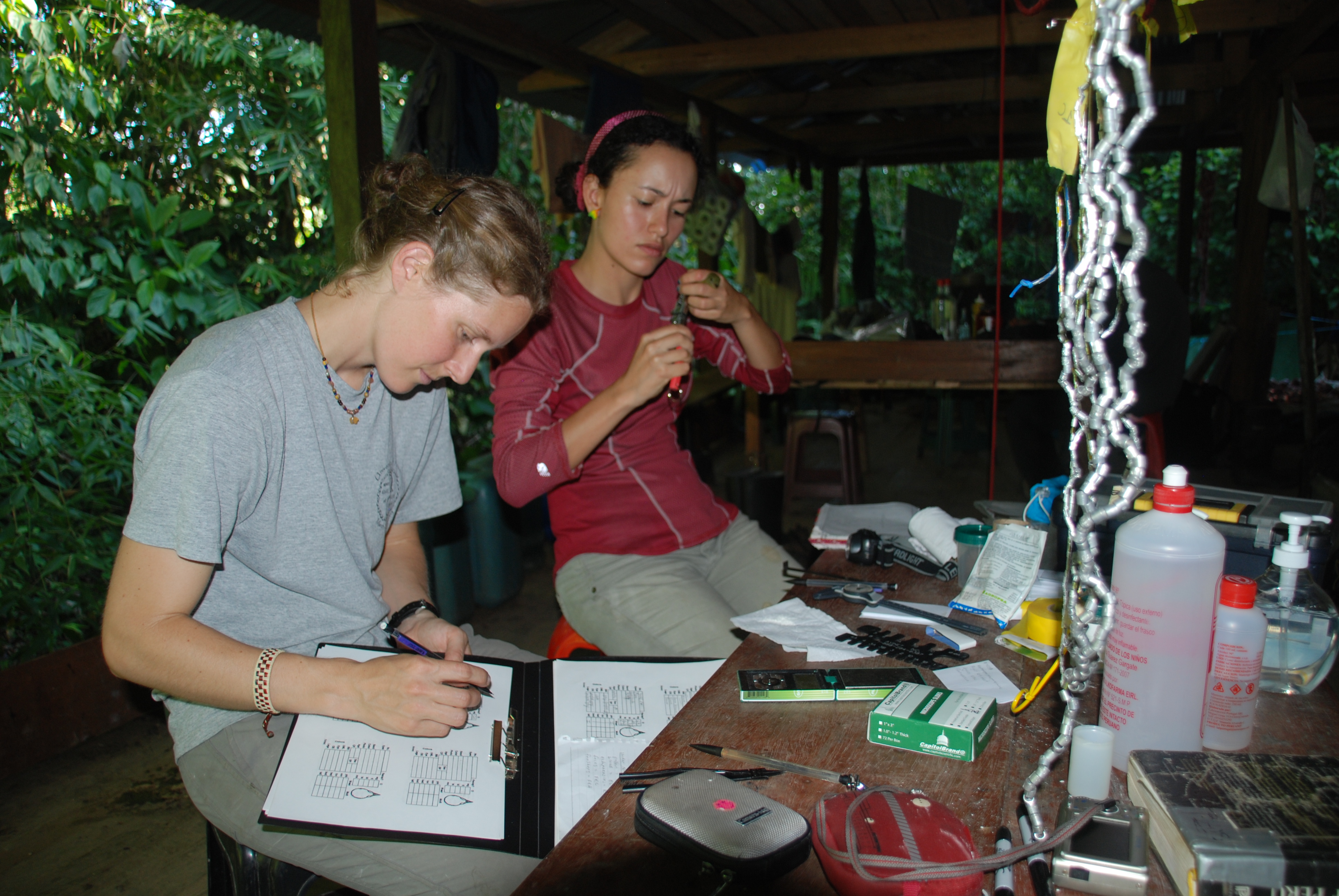Peruvian Andes & Amazon Colombian Andes Costa Rican Cloud Forest Congo Basin
Back to Home
|
A
primary goal in our research is to understand spatial
patterns of species diversity in the tropical Andes. In the Manu Biosphere Reserve, we use
audio-visual counts and mist nets to survey birds along a 3000-m
elevational
gradient, ranging from the Amazon basin to treeline (400-3400m). We use
these data to quantify avian richness and species turnover, and to
assess how landscape heterogeneity, influenced by landslide disturbance, contributes to these diversity patterns.
These data also serve as training and
test data for modeling species' response curves with
elevation and for comparisons of diversity patterns to other taxa. We have documented extremely high species turnover along tropical elevational gradients, with 100% change in community composition in 500 m elevation (twice as high as the rate of species turnover along temperate mountainsides in the Eastern US). Patterns of species turnover in birds correspond to changes in tree communities and to structural components of vegetation. The position of the cloud bank and gradients in moisture are also important predictors of community composition in these regions, factors we can expect to be altered by climate change. *Scholer, M.N., Jankowski, J.E. (2019) New and noteworthy distributional records for birds of the Manu Biosphere Reserve. Cotinga 41: 87–90. Jankowski, J.E., Londoņo, G.A., Robinson, S.K., Chappell, M.A. (2013) Exploring the role of physiology and biotic interactions in determining elevational ranges of tropical animals. Ecography. 36: 1-12 (Editor’s Choice) Jankowski, J.E., Merkord, C.L., Rios, W.F., Cabrera, K.C., Salinas R., N., Silman, M.R. (2013) The relationship of tropical bird communities to tree species composition and vegetation structure along an Andean elevational gradient. Journal of Biogeography. 40: 950-962. See other publications (first authored by assistants) from the Manu Project here |
Cloud forest after a mid-afternoon rainstorm in Manu at 1700 m |
Eutoxeres condamini is found in the lower elevations of Manu National Park. We might expect this species to be specialized to few flowering plant genera based on its bill morphology. Photo by Zach Peterson. To collect pollen we rub a small slice of prepared gelatin over the hummingbird's bill and forehead. This gelatin is then melted and fixed on a microscope slide under a glass coverslip. Photo of Ocreatus underwoodi by Zach Peterson. | Hummingbirds and Flowering Plants in the Andes The
highest diversity of hummingbirds is found in the Andes of
South America,
where species often have elevational distributions of only a few hundred
meters. Despite well-studied specialization to flowering-plants in some species,
no one has examined how relationships between hummingbirds and
flowering plants may constrain hummingbird species’ elevational
distributions. One advantage of hummingbirds
is that they leave a record of which flowers they have visited through
accumulation of pollen on their bills and heads. In our project, we are using the Neotropical Pollen
Database
develolped by the Palynology lab of Mark Bush to help identify
pollen samples
collected from bills of captured hummingbirds across elevations in Manu
and to describe the dietery composition for >30 species.
Combined with data on occurrence of hummingbird and flowering-plant species along the same gradient, we can ask: Do range limits in hummingbirds coincide with limits in the distribution of their flowering plants? Do hummingbirds with broad distributions change their use of flowering-plant resources with elevation? Are specialist hummingbirds constrained to narrower elevational ranges compared to generalists? My students are working on hermit species like Sicklebills (photo left) and the evolution of curvature in flower corollas, and territoriality and spatial use by high elevation hummingbirds like the Shining Sunbeam. *Boehm, M., §Guevara Apaza, D., Jankowski, J.E., Cronk, Q. (2022) Floral phenology of an Andean bellflower and pollination by Buff-tailed Sicklebill hummingbird. Ecology and Evolution 12(6): e8988. *Boehm, M., Jankowski, J.E., Cronk, Q. (2022) The inside curve: geometry and pollination ecology of curved flowers. American Naturalist 199(2): 206–222. *Pavan, L., Hazlehurst, J., Jankowski, J.E. (2020) Patterns of territorial space utilization in a tropical montane hummingbird (Aglaeactis cupripennis). Journal of Field Ornithology.00: 1–12. DOI: 10.1111/jofo.12321 *Cespedes, L., *Pavan, L., Hazlehurst, J., Jankowski, J.E. (2019) The behavior and diet of the shining sunbeam (Trochilidae): A territorial, high elevation hummingbird. Wilson Journal of Ornithology 131: 24-34. DOI: 10.1676/18-79.1 *Boehm, M., *Scholer, M., *Kennedy, J., *Heavyside, J., Daza, A., *Guevara-Apaza, D., Jankowski, J. (2018) The Manú Gradient as a study system for bird pollination. Biodiversity Data Journal 6: e22241. DOI: 10.3897/BDJ.6.e22241 *David, S., Jankowski, J.E., Londoņo, G.A. (2018) Combining multiple sources of data to uncover the natural history of an endemic Andean hummingbird: The Peruvian Piedtail. Journal of Field Ornithology 89: 315-325. *Dyck-Chan, L., *David, S., Jankowski, J.E. (in revision for Journal of Field Ornithology) Resource specialization and range overlap of tropical hermit hummingbirds. |
|
Andean
birds and vegetation: remotely
sensed data for distribution
modeling
and diversity mapping
The study of biodiversity in tropical montane forest has long been plagued by an inability to access and sample the heterogeneity of these landscapes. Birds are among the most well studied taxa, yet even the most detailed studies of avian distribution in tropical mountains describe elevational ranges by limits of occurrence along single transects, or estimated abundance based on limited spatial sampling. For birds, we know that vegetation structure and complexity are important predictors of species richness and are used in habitat selection for individual species, but ground-based vegetation sampling is time-consuming, spatially limited and sometimes dangerous in steep mountainous terrain. Advances in remote sensing, however, now allow detailed and quantitative measures of vegetation to be gathered over thousands of square kilometers. This could be enormously useful for understanding patterns of diversity and distributions. This proposed project aims to combine our data on tropical bird abundances along the elevational gradient in Manu with iterferometric Synthetic Aperature Radar (inSAR) data for the study area. Using variables derived from radar (e.g., canopy height, above-ground biomass), we can generate landscape-scale predictions for bird species richness, variation in species composition (beta diversity) and individual species' distributions in Andean landscapes, including population size estiamtes for the best modeled species. Our goal is to use remote sensing and GIS applications to construct informative maps of spatail patterns of avian diversity for the montane regions of Manu National Park. |
 Overview of Departments of Cusco and Madre de Dios, Peru. Yellow and blue swaths indicate flight paths for remotely sensed radar data. The yellow swaths, collected in July 2009 by Earth Data, Inc., cover the montane portion of the Manu region. |
| Understanding
evolutionary relationships of Andean
birds through ectoparasitic chewing lice An
assortment of ectoparasites live on birds, among which are chewing lice
specialized to the wing and body feathers. These parasites often
track the evolutionary histories of their hosts, though this occurs in
differing degrees of cospeciation. Such relationships give us the
opportunity to study microevolutionary processes in bird hosts at regional spatial scales, such as dispersal, gene flow and
population divergence, as well as macroevolutionary patterns
of host-parasite coevolution in species groups distributed across
biogeographic provinces.
As part of our research efforts in Manu, we have collected ectoparasites from captured birds using a feather dusting technique. With these data, we are joining forces with bird lice experts and collections at the University of Nevada, Reno and the Field Museum of Chicago to investigate micro- and macroevolutionary patterns in Amazonian and Andean birds. Soto Patiņo, J. Londoņo, G.A., Johnson, K.P., Wechstein, J.W., Avendaņo, J.E., Jankowski, J.E., Catanach, T.A., Sweet, A.D., Allen, J. (2018) Composition and distribution of lice (Insecta: Phthiraptera) on Colombian and Peruvian birds: New data on louse-host associations in the Neotropics. Biodiversity Data Journal 6: e21635 DOI: 10.3897/BDJ.6.e21635. |
 This
Crowned Chat-Tyrant (Ochthoeca spodionota) was feeding nestlings near
treeline at 3400 meters. Perhaps due to this constraint, she didn't
have time to preen feathers, leaving them susceptible to chewing lice.
The barbs on her chest contour feathers have been completely
eaten, leaving only the rachii.
|
Cloud
forest habitats are moisture-saturated, resulting in moss-laden tree
trunks and unmatched epiphyte diversity and abundance. Our study
shows that range boundaries of numerous bird species coincide with the
lower limit of cloud forest along the steep biophysical gradients of
the Pacific slope.
|
Endemism,
beta-diversity, and consequences of
climate change in Central American cloud forests
The leeward Pacific slope of the Tilaran Mountains offers a unique opportunity to examine the effect of steep biophysical gradients on the organization of biodiversity. A central feature of this gradient is the "cloud forest margin" which is characterized by major shifts in vegetation structure and punctuated species turnover. This mountain range also exhibits extraordinarily high levels of endemism, harboring numerous species limited to Central America and an even greater proportion of species limited to the Costa Rican - Panamanian highlands. The combination of climate warming and regional deforestation are expected to generate serious warming and drying effects on the cloud forests of this region, adding to the need for urgent and precisely placed conservation efforts. Our research of the bird and tree communities of this landscape spans a decade, in which time we have quantified the diversity of avian and tree communities and the correlative effects of temperature and moisture on species composition along the gradient. We have found that many narrowly endemic birds tend to be numerically rare, in addition to being habitat specialists, creating a "syndrome of rarity" for many cloud forest inhabitants. Our yearly censusing of the bird community now allows us to assess yearly variation in abundances of cloud forest species and to provide critical data for analysis of population viability for endemic species. Jankowski, J.E., Kyle, K.O., Ciecka, A.L., Gasner, M., Rabenold, K.N. (2021) Response of avian communities to edges of tropical montane forests: Implications for the future of endemic habitat specialists. Global Ecology and Conservation 30: e01776. DOI: 10.1016/j.gecco.2021.e01776 Gasner, M.R., Jankowski, J.E., Ciecka, A.L., Kyle, K.O., Rabenold, K.N. (in prep for Ecological Applications) Population variability in tropical birds and implications for the design of monitoring studies. Gasner, M.R., Jankowski, J.E., Ciecka, A.L., Kyle, K.O., Rabenold, K.N. (2010) Projecting impacts of climate change on Neotropical montane forests. Biological Conservation 143: 1250-1258. Jankowski, J. E., Ciecka, A.L, Meyer, N.Y., Rabenold, K.N. (2009) Beta diversity along environmental gradients: Implications of habitat specialization in tropical montane landscapes. Journal of Animal Ecology 78: 315-327. Jankowski, J.E. & Rabenold, K.N. (2007) Endemism and local rarity in birds of Neotropical montane rainforest. Biological Conservation 138: 453-463. |
This Gray-breasted Wood-Wren (Henicorhina leucophrys) replaces the White-breasted Wood-Wren (H. leucosticta) in the Tilaran mountains of Costa Rica. Photo by Rosalbina Butron. |
Elevational
species
replacements: Testing the
Interspecific Competition
Hypothesis in Neotropical Birds
The phenomenon of elevational replacements between closely related species is well documented in tropical birds, especially in the Neotropics. It is assumed that interspecific competitive interactions underlie these replacements, preventing the coexistence of strong competitors. In his study of the Vilcabamba elevational gradient, Terborgh (1975) concluded that competitive interactions could limit the elevational ranges for up to 30% of montane birds. These conclusions were based primarily on distribution patterns of congeners along single gradients, with evidence for range expansion along mountain slopes where one congener was absent. Until now, experimental evidence to support the interspecific competition hypothesis in tropical mountains has been lacking. My project used interspecific playback experiments to test for territorial behaviors between species in contact areas along elevational gradients. Aggressive territorial interactions between species would support the hypothesis that interspecific competition maintains these range boundaries in montane species exhibiting elevational replacements. Using recorded songs of target species, I conducted a series of playbacks (control, congener, and conspecific trials) to birds holding territories in replacement zones, and at increasing distances from these zones, where interspecific encounter rates decline precipitously. I have conducted these playback experiments in both the Tilaran Mountains, Costa Rica, and in Manu National Park, Peru. Results from the Tilaran mountains of Costa Rica show that species respond aggressively to congener songs in playback experiments where species come into contact along the gradient. As one moves away from the replacement zone, however, responses to congener songs grow weaker, and at distances well within the elevational ranges of these species, responses to congener songs cannot be distinguished from responses to negative control playbacks. While species in Costa Rica showed aggressive interactions with congeners at range boundaries, the strength of interspecific aggression varied between species and among genera, suggesting that some species could be behaviorally dominant. We emphasize that interspecific aggressive interactions at range boundaries, and especially asymmetries in interactions could pose constraints on species as they shift in response to changing climate regimes. Jankowski, J.E., Touchton, J.M., Graham, C.H., Robinson, S.K., Parra, J.L., Seddon, N., Tobias, J.A. (2012) The role of competition in structuring tropical bird communities. Ornitología Neotropical. 23: 115-124. Jankowski, J.E., Robinson, S.K., Levey, D.J. (2010) Squeezed at the top: Interspecific aggression may constrain elevational ranges in tropical birds. Ecology 91: 1877-1884. (Cover Article) |
Oyala, Equatorial Guinea
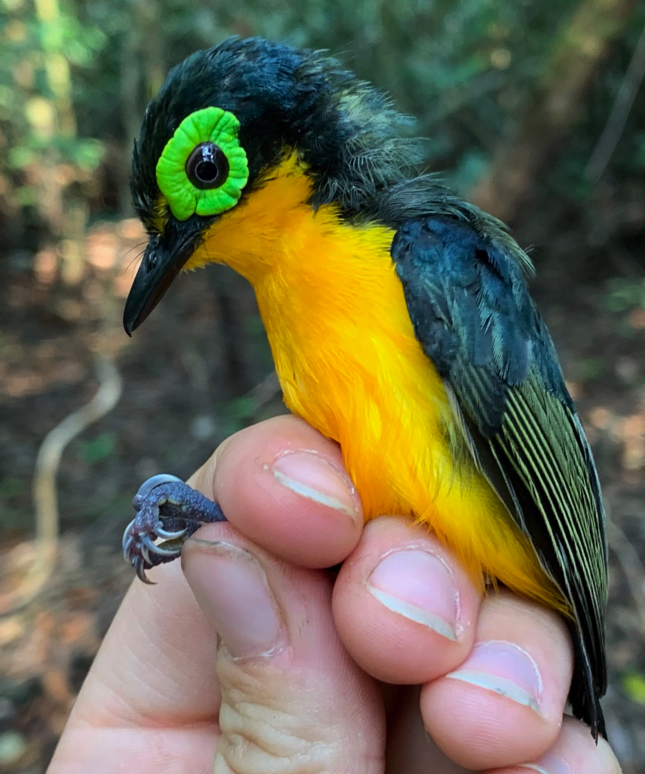 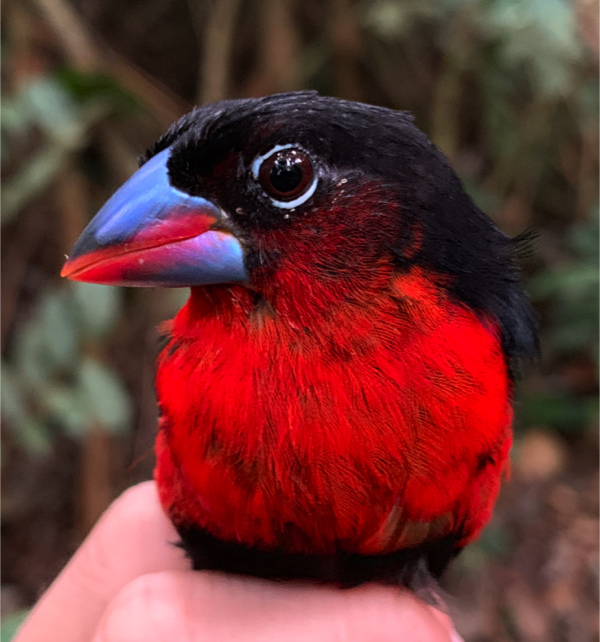 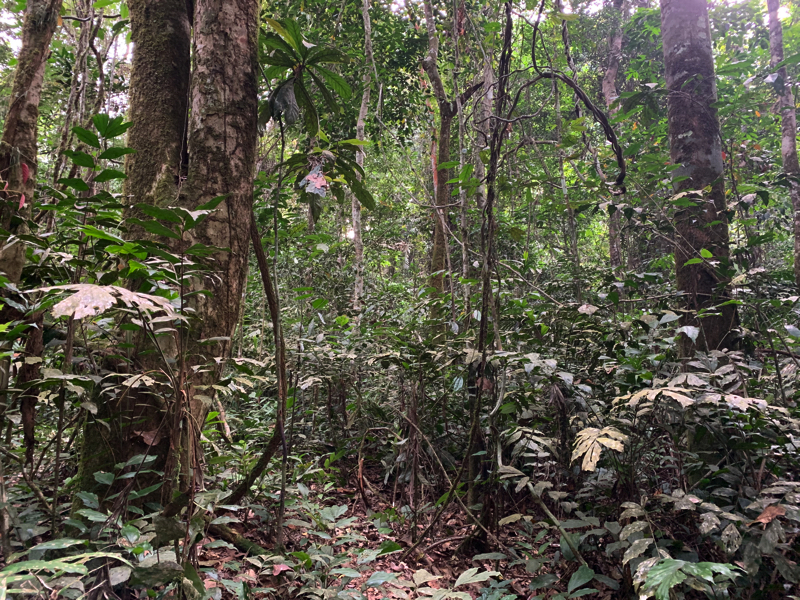 Lowland
forest in Equatorial Guinea is home to spectacular birds, including
this Yellow-bellied Wattle-eye and Western Bluebill shown in the hand.
These species differ greatly in their feeding guild and consequently,
their functional roles in Afrotropical forests.
|
Assessing the impacts of forest degradation on birds in West-Central Africa
Tropical landscapes often exist as a mosaic of intact old-growth forest and degraded or regenerating forest. It is critical to understand how these landscapes maintain biodiversity and ecosystem functioning. Because responses to habitat degradation are mediated by species’ traits, aspects of the environment (e.g., forest vegetation structure, microclimate) can impact how different functional groups respond to habitat perterbations. We can better understand how and why species respond to changes in habitat at the regional scale by evaluating how traits relate to those features at the local scale. A species’ realised niche is not only determined by its abiotic tolerances but also by biotic interactions. As such, investigating the ways in which communities express vulnerability to habitat change at different scales, including social aggregations such as mixed species flocks, can provide a more comprehensive picture of the drivers of change in tropical avian communities. The lowland tropical forests of West and Central Africa are among the most understudied globally, and major gaps exist in our understanding for how resident birds is the Congo Basin and Upper and Lower Guinea forests respond to changing forest landscapes. In collaboration with Biodiversity Initiative, our research aims to unpack the relationship between species, their functional traits, behaviours and sociality, and the structural characteristics of forests they occupy. From this, we can better understand what is driving local species extirpations, or population shifts following habitat change or loss, and how this may extend to larger population trends in the region. |
Paramos and Cloud Forest, Colombia
| Bird communities above treeline: Paramos in the Eastern Andes of Colombia Paramos
are high elevation ecosystems above forest treeline, occurring at
elevations of c. 2800–4300 m above sea level. These areas are
discontinuously distributed in isolated mountaintops, forming an
archipelago-like distribution that exhibits harsh abiotic conditions,
such as drastic daily changes in temperature, high ultraviolet
radiation and low oxygen pressure. Bird communities restricted to the
Paramo are highly vulnerable to the combined effects of local
fragmentation and shifting abiotic and biotic conditions with climate
change.
Our ability to predict the responses of tropical high elevation species to global changes in climate and land use depends on detailed knowledge of the life histories and behavioral adaptations that allow them to tolerate extreme environmental conditions. In our research in the Paramos of Colombia, we use field experiments, observations and comparative analysis to study the life history traits and breeding strategies of tropical high-elevation specialists, as well as the role of species interactions in determining the elevational range limits of tropical birds. | 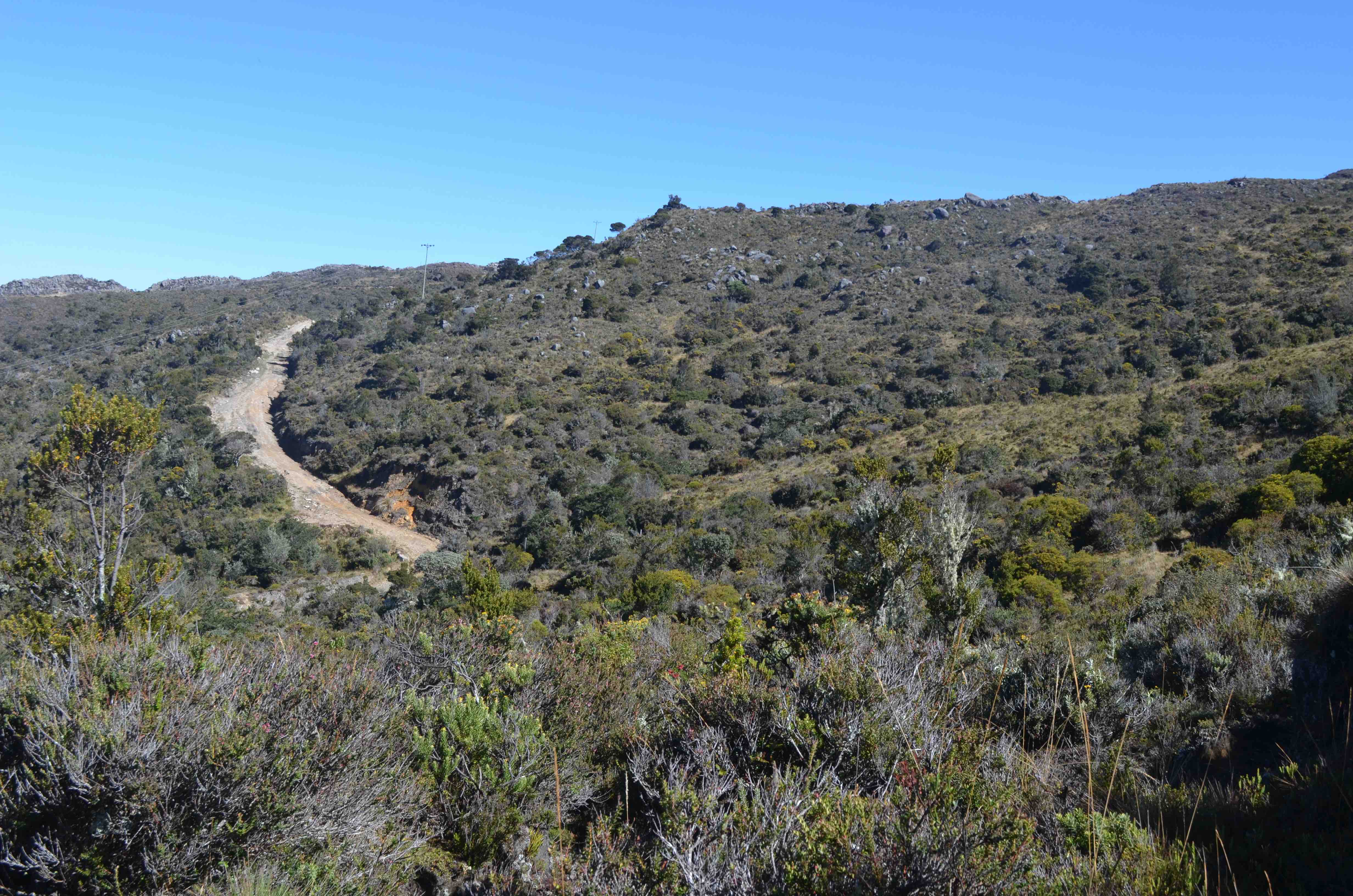 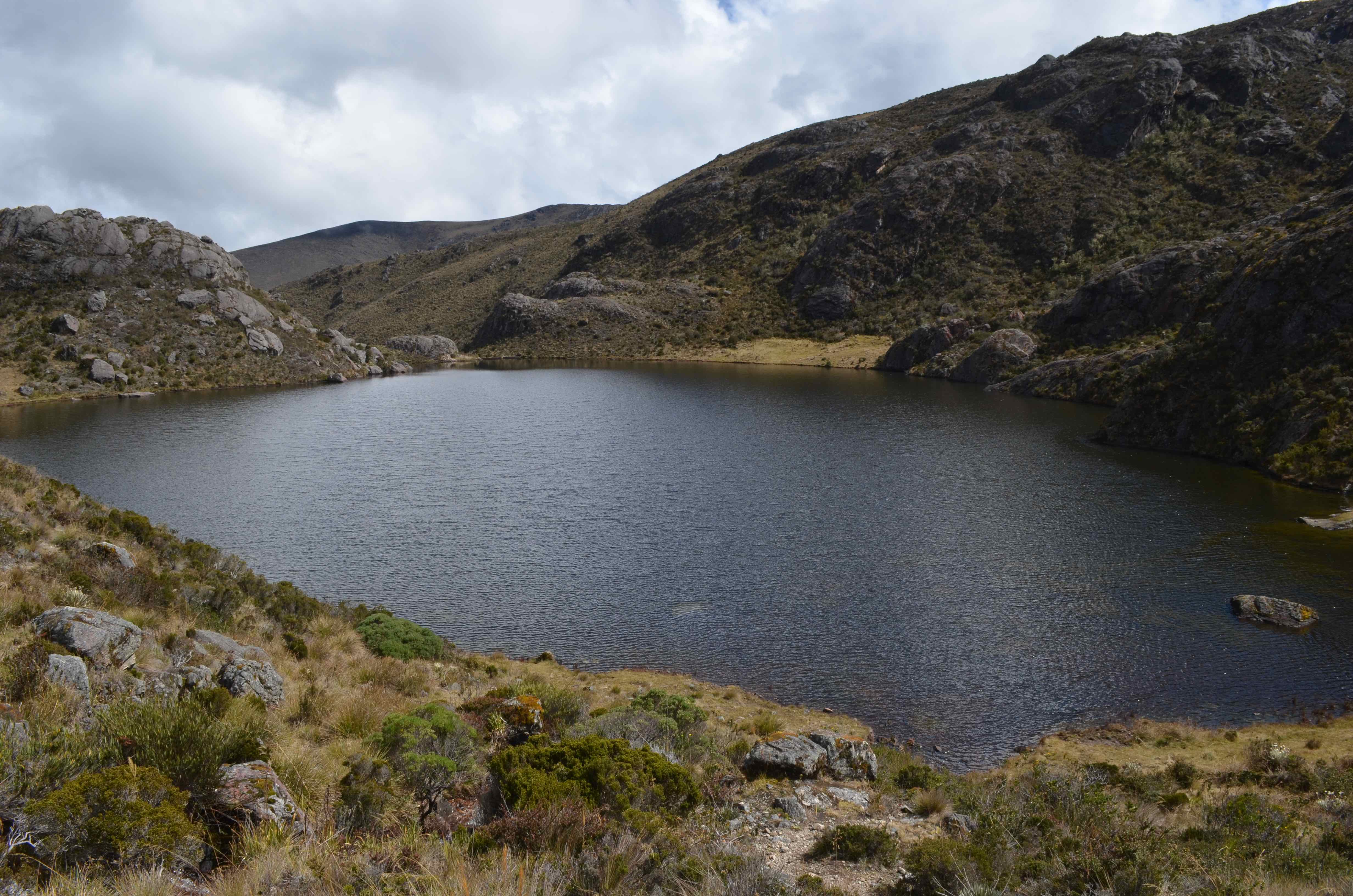 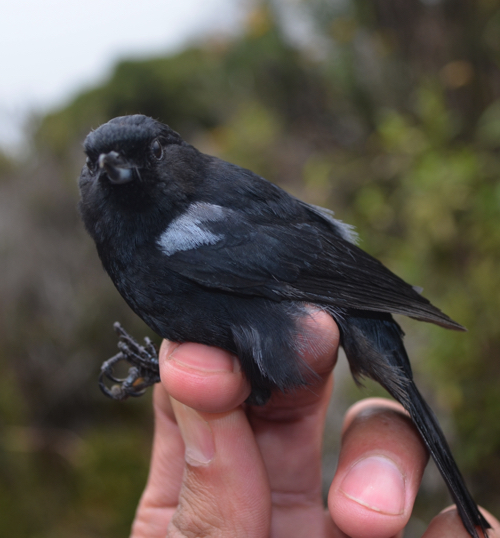 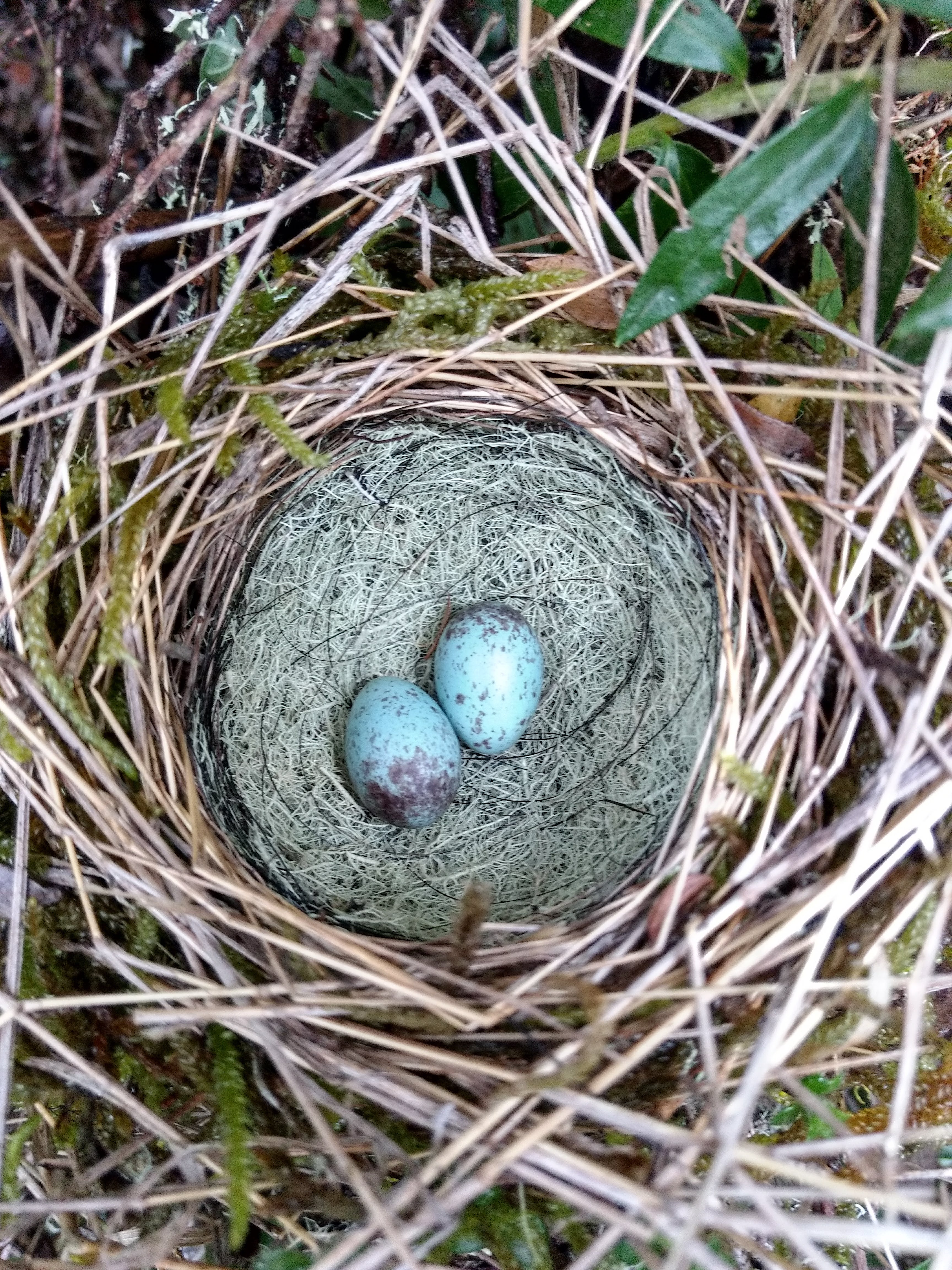 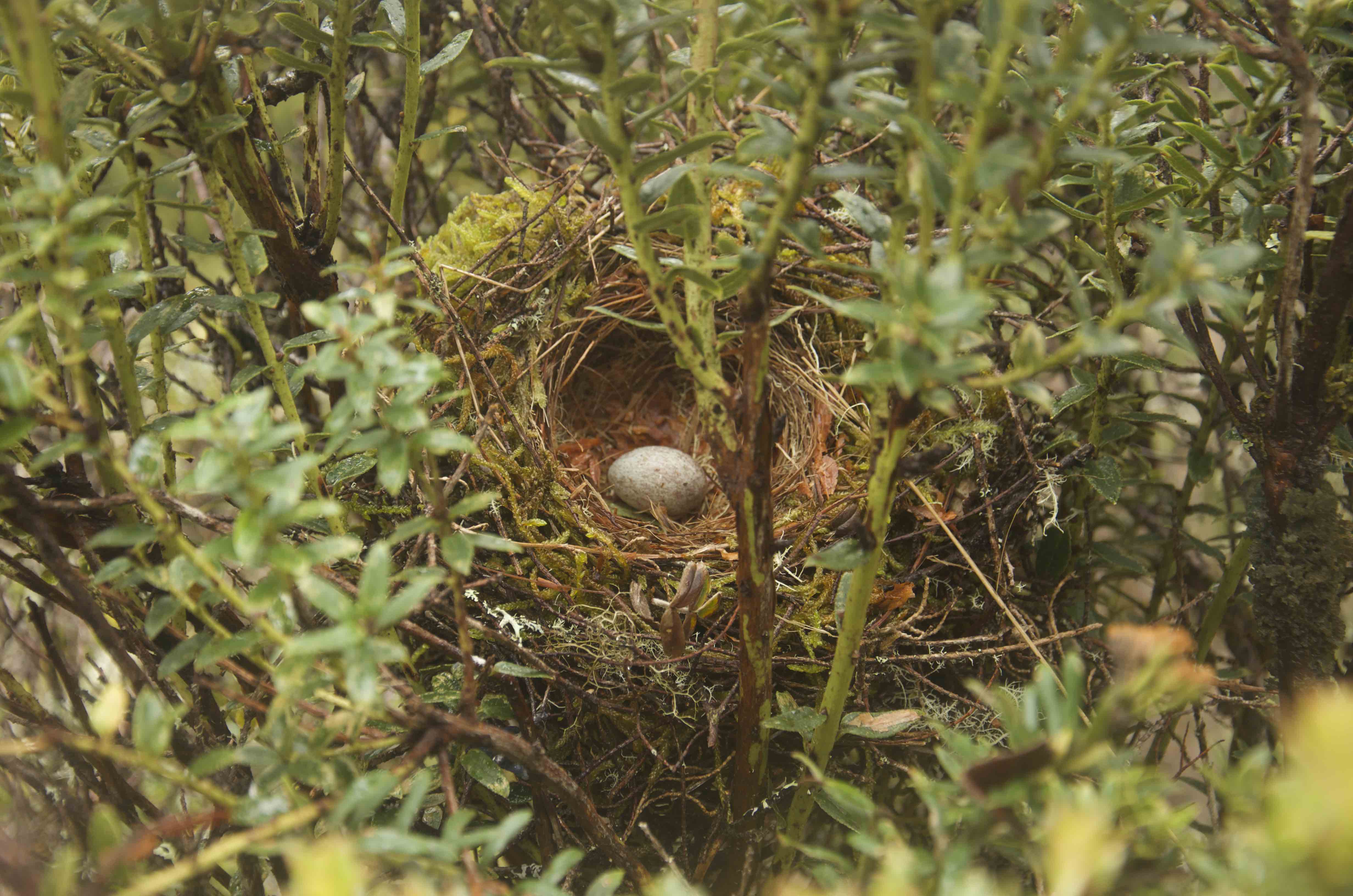 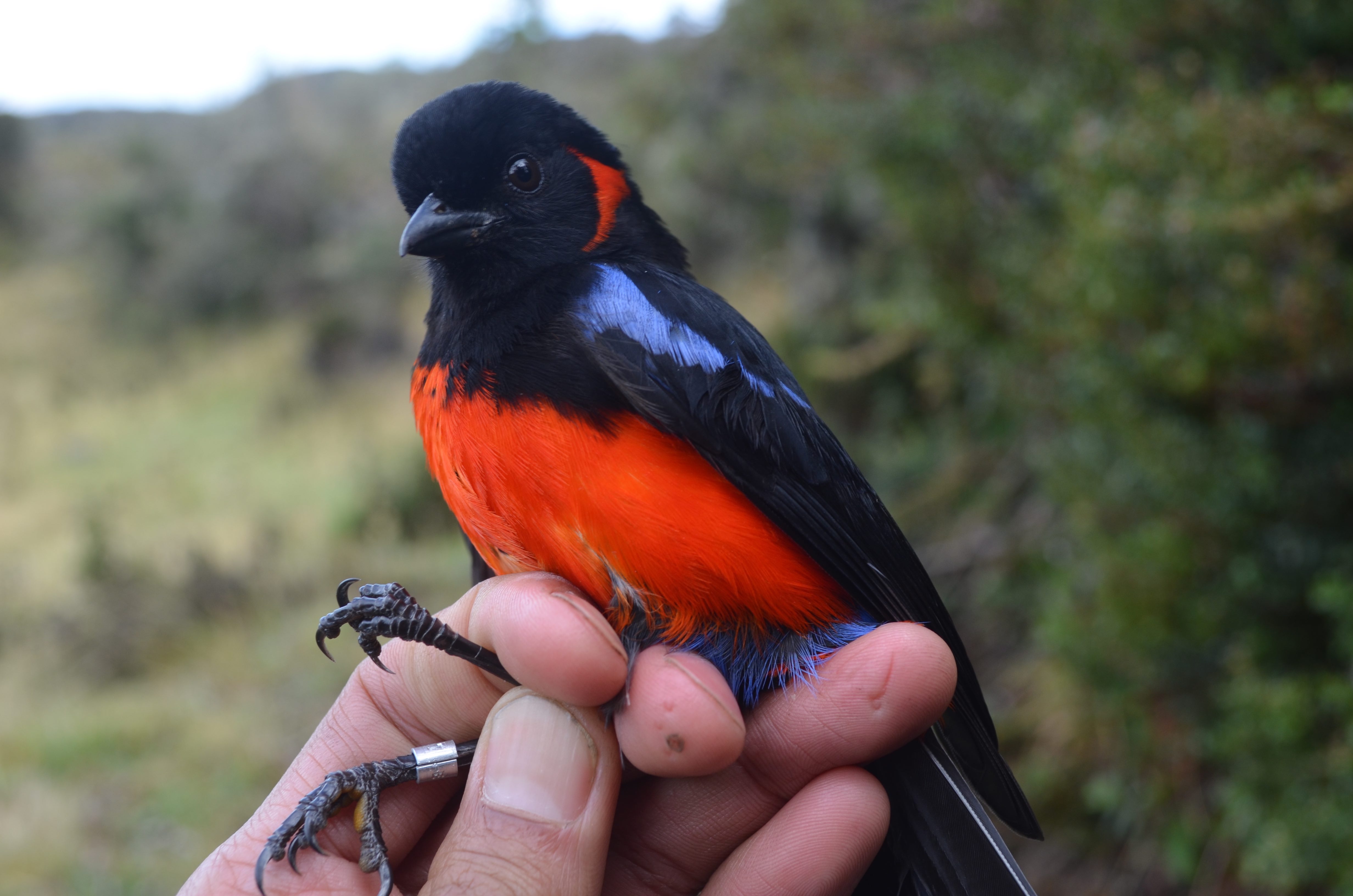 Black
Flowerpiercers (Diglossa humeralis) and Scarlet-belled
Mountain-Tanagers (Anisognathus igniventris) are common bird species
that nest in the paramo habitats of Colombia. Like other high-elevation
tanagers in the Andes, this Anisognathus species has a clutch size of
only one egg.
|
Top
Back to Home
